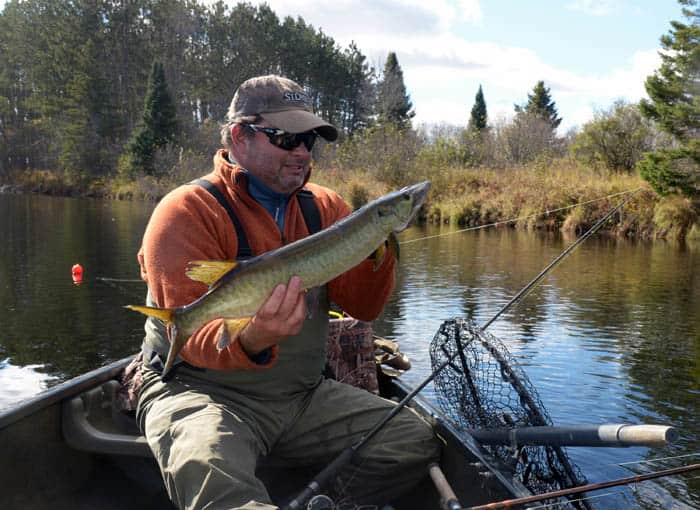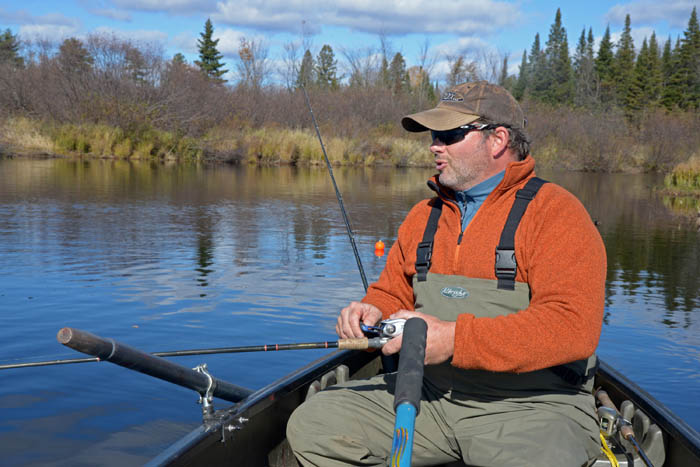Canoeing Wisconsin’s Northwoods in Search of River Muskie
Patrick Durkin 11.30.15

You know it’s autumn in the Wisconsin Northwoods when you pause between casts to pluck red, brown, and yellow leaves from your muskie bait’s treble hooks.
And just to confirm winter lurks over one horizon while summer loses its grip on the other, you realize your lightweight gloves spent half the afternoon on your hands and the other half drying in the sun atop your boat seat.
All the while, John Maier kept his small guideboat well-positioned in the river’s current, seemingly casting with one hand while rowing with the other. Maier, 49, a marketing instructor at Northeast Wisconsin Technical College in Green Bay, also runs True North Guiding and Outfitters with his wife, Brenda, from Boulder Lodge on Ghost Lake.
The Maiers pride themselves on taking people off the beaten path, which isn’t easy work in northwestern Wisconsin. After all, anyone can locate the region’s countless small lakes and narrow rivers on a map or aerial photo. But getting a canoe or small boat in and out of such sites requires lots of hiking, exploring, and planning before your craft ever sees water.
After meeting my wife and I at the Clam Lake Junction gas station on a recent Saturday morning, Maier loaded my gear into his truck while directing Penny to the Cable Museum of Natural History. If she hurried, she could catch part of Brenda’s seminar on handcrafting walking sticks from tamarack poles.
Maier and I then drove about 20 minutes down gravel roads and grassy two-tracks to a secluded turnaround in the Nicolet-Chequamegon National Forest.
“The river’s over there,” Maier said, gesturing over his shoulder as he unlashed a canoe and handed me a six-pack of fishing rods rigged for muskies, walleyes and smallmouth bass. “Follow me,” he said, and took off downhill with the canoe atop his shoulders.
The narrow path in the riverbottoms was easy to follow, but Maier did a better job guiding the canoe’s bow through the overhanging tag alders than I did toting the fishing rods. I stopped at least four times to pull rod tips and braided line free of branches, only to snag them again a few steps later.
We left the canoe and two paddles at the trail’s end for Brenda and Penny, who would follow us downriver sometime after lunch. Maier noticed the river was about six inches lower than it had been the previous week when he and Brenda fished it during an autumn heat wave. They caught several muskies that day, but a cold snap two days before my arrival dropped the air temperature about 40 degrees.
I settled into the guideboat’s bow seat as Maier pushed it away from shore and down a long riffles to the river’s main channel. Almost immediately he pointed to fallen trees along the shoreline, recounted the muskies they’d caught there the previous week, and told me to work my bucktail spinner along their edge.
After setting a pole out the boat’s stern with a large sucker, Maier started casting a medium-sized stickbait. Minutes later I heard a watery hiss as heavy braided line ripped into the air as Maier set the hook. “There’s a fish!” he said as the heavy rod bent under the strain. He expertly worked a muskie away from the shore and toward the boat.

“It’s a small one, but grab the net,” he said.
Before long I slid the landing net under the muskie, leaned toward Maier, and handed him the net’s long handle. Maier kept the 30-incher in the water while freeing it from the treble hooks and then, at my request, hoisted it up for a couple of photos.
“That’s a good start,” I said, and resumed casting. The current soon carried us past the trees and toward the first of many river bends. We worked the bend’s outside edge where the current gouged out deep holes, but nothing hit.
Maier handed me the rig he used to catch the muskie, and gave me a few tips on how to work the shallow-running stickbait. “Don’t reel too fast, and give it a twitch every few cranks,” he said.
I did as instructed as we kept floating downriver, pausing only to remove weeds and fallen leaves from my hooks, and occasionally warm my wet hands inside my vest.
I’ve been in many remote, scenic places in my life, but few as pristine as this river. Maier assured me there’s no shortage of such rivers and remote lakes in northwestern Wisconsin. “We rarely see other fishermen out here, especially this time of year,” he said. “If you have to walk in to fish, you’ll usually have the place to yourself.”
About 4:30 p.m., nearly four hours into our trip, I was reeling and twitching the stickbait along the shoreline when Maier announced we had visitors. I looked but couldn’t see anyone, and he noticed my puzzled look. “They’re still around the bend, but I hear Brenda and Penny talking,” he said.
Sure enough, their red canoe soon came into view, with their varnished wooden paddles reflecting the late-afternoon’s golden light.
Their timing couldn’t have been better. We were nearing our take-out spot, and it was clear we’d have to quit with only one fish. We took a few minutes to discuss our days, and then resumed fishing, floating and paddling.
We soon reached the unmarked trail that led to Brenda’s car, and pulled into shore. We then hoisted our gear from the boat and canoe, divided the loads, and followed Maier as he took off up the trail with the canoe again atop his shoulders.
As with most guides, Maier said the hike out was shorter than it was in actuality, so I wasn’t surprised when the “half-mile” walk stretched to about three-quarters of a mile. Either way, he had long ago disappeared from sight in the smoky-gold foliage of poplars and tamaracks. Later, just when we started thinking we might have missed a turn on the subtle trail, Maier returned looking for us.
“The car’s just ahead,” he announced, looking like he was ready for another four hours on the cold, wind-swept river.
But that would have to wait another day. The sun was disappearing below the tree line, and the Northwoods’ best stuffed pizza was awaiting us at the Chippewa Tavern in Clam Lake.

